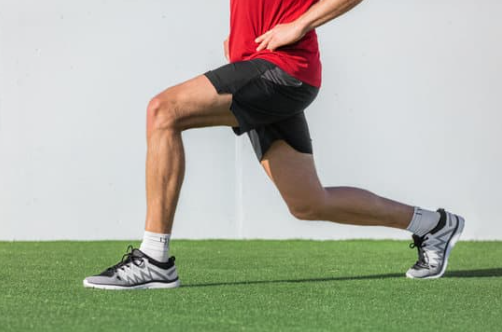Cold muscles do not absorb shock or impact as well, and are more susceptible to injury. While scientific studies are ongoing to define the best warm-up techniques for injury prevention, the warm-up in general is firmly established as a key to exercising safely and effectively. A warm-up should be done before strength training, aerobic (and anaerobic exercise) and stretching.
A warm-up should be sport-specific, which means that it mimics the activity you’re about to do, but at a lower intensity, lower impact, and/or slower speed. For example, you’d walk before running. Other general warm-ups include the stationary biking, using the elliptical machine or light stair climbing. Exercises that use your arms and your legs (such as a Nordic Track or Air Dyne bicycle) are great for a total-body warm-up. A good warm-up before strength training is to do the exercises you are about to perform with a very light weight first. Contrary to popular belief, stretching is not the same thing as warming up. In fact, stretching should come at the very end of your workout for best results.
What are the Benefits of Warming Up?
A warm-up helps you prepare both mentally and physically for exercise, and reduces the chance of injury. During a warm-up, any injury or
Increased movement of blood through your tissues, making the muscles more pliable.- Increased delivery of oxygen and nutrients to your muscles. This prevents you from getting out of breath early or too easily.
- Prepares your muscles for stretching
- Prepares your heart for an increase in activity, preventing a rapid increase in blood pressure
- Prepares you mentally for the upcoming exercise
- Primes your nerve-to-muscle pathways to be ready for exercise
- Improves coordination and reaction times
How to Warm-Up
When warming up, keep the FITT Principles (Frequency, Intensity, Time and Type) in mind.
- Frequency: How often you should warm-up
A proper warm-up should be done before any exercise session or physical activity, whether it is a cardio, strength training workout or stretching. - Intensity: How intensely you should warm-up
A warm-up should start with exercises of low intensity and then progress to match the intensity of the main exercises of the workout. The greater the intensity of the workout, the longer its warm-up should be. Speed, strength and difficult technical workouts should have longer warm-ups than aerobic fitness or endurance workouts. A general recommendation is to perform a warm-up that includes all the large muscle groups of the body.
For an effective warm-up, perform movements that increase your heart rate and breathing, and slightly increase the temperature of your muscle tissue. A good indication of this is when you have raised a light sweat. Your warm-up should be nice and easy. If it makes you too tired, try doing less strenuous warm-up exercises. - Time: How long your warm-up should last
Your warm-up should last at least five to 10 minutes (or slightly longer in cold weather or before high-intensity exercise). Breathing will be harder than normal, but not as hard as during the actual exercise. - Type: What activities are suitable for warming up?
See "Examples of Warm Up Activities" above. The warm-up can be a lower intensity version of the workout you are about to do, or it can be a completely different exercise. As long as it increases your heart rate and breathing, and involves the muscles you are about to use, it is considered a proper warm-up.





.png)


.png)




